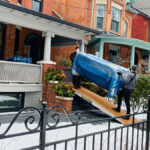How to survive moving in winter
While most moves take place during the summer months, if you choose to move in the winter, don’t be afraid of a little chill. You may be surprised to find out there are some benefits to planning a move in the wintertime.
Winter months — December, January, February — are off-peak for moving companies, which can mean more competitive pricing and a wider range of move dates from which to choose. However, before you roll up your long sleeves and dig into a cold move, consider these six winter moving tips to help keep you on track.
Make sure your utilities are turned on and fully functioning at your new house.
The last thing you want is to show up at your new residence, in the dead of winter, with no working heat or light. Winter days are shorter, which means you will have less daylight to work with on move-in day. That’s why you’ll want to make sure your heat, water, gas and electric are up and running approximately two days before you move in.
Clear the walkways, driveway and street.
Regardless of the time of year you decide to move, it’s always a good idea to visit your new home before move-in day and take note of any safety hazards. This is especially important in winter months when slippery conditions can be your worst enemy. Make sure all walkways are free of ice and snow; salt or use sand to secure pathways. Also, check to make sure you have enough parking that is not on a plow route. You don’t want your movers having to trudge through muddied snowbanks while loading and unloading your belongings.
Keep winter wear close at hand.
Speaking of hands, make sure you have warm gloves and some extra ones for layering when the snow picks up. Even if you hire a full service moving company like ComfyMove to move your belongings, you will want to make sure you have your winter necessities accessible. If there’s a chance of sleet or snow on your moving day, make sure to pack changes of clothes in your first night kit.
Make sure your floors are covered.
The sludgy mix of snow, ice and mud combined with supplies to combat the elements, rock salt and sand, can wreak havoc on your floors. Place floor mats at entrances to all outside doors and plastic tarps over wood floors; for carpeted areas, use cardboard sheets secured with small tacks. Keep in mind, most professional moving companies will come prepared because they understand how important it is to help protect highly trafficked areas in your home.
Stock up on winter supplies.
You never know when you’ll need to dig your way out of a snowy situation, not only for foot traffic but also in case your vehicle gets stuck. Salt and sand should be readily available along with a shovel. If you own a snowblower, even better! It’s also a good idea to have a space heater accessible just in case temps get super low and you need to provide supplemental heat near an entrance or cold zone.
Keep an eye on the weather and adjust accordingly.
With so much going on during your move, it may slip your mind to track weather conditions. Set a reminder to check the weather at least a week leading up to your move date, right up until the movers are scheduled to arrive. It’s best to discuss the possibility of weather hindrances and rescheduling policies with your movers at the time you receive a moving quote. That way, everyone is on the same page and you can have a backup plan should weather postpone your move date.
Need help with your winter move? We offer full-service moving so all you have to worry about is enjoying your new neighborhood and settling into your new home. Schedule a consultation with one of our moving experts today!


